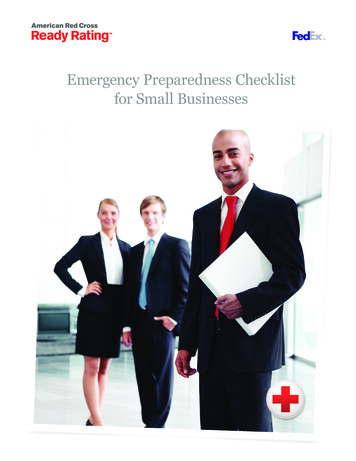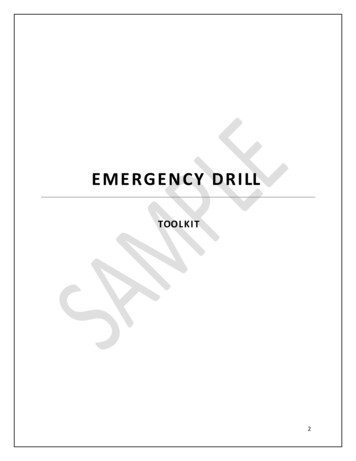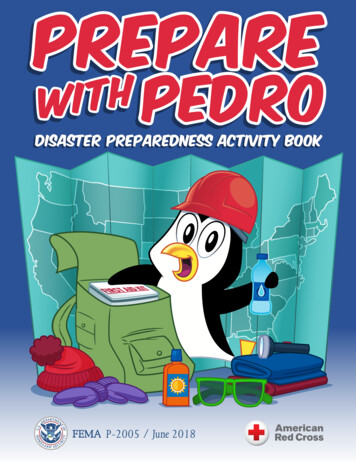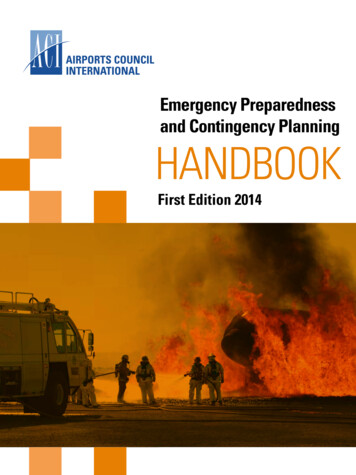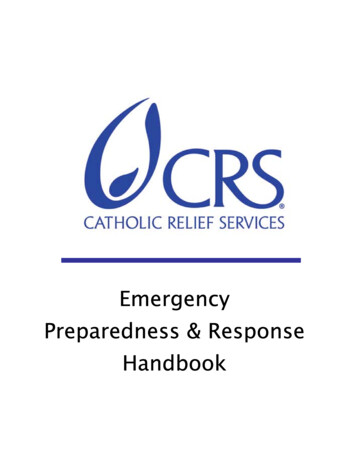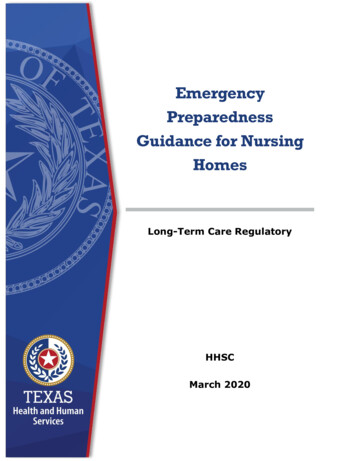
Transcription
EmergencyPreparednessGuidance for NursingHomesLong-Term Care RegulatoryHHSCMarch 2020
Table of Contents1. Introduction . 12. State Rules . 2The Plan .2Risk Assessments .2Core Function: Warning .3Core Function: Communication.3Core Function: Sheltering Arrangements .4Core Function: Health and Medical Needs .4Core Function: Resource Management .5Training .5Self-Reported Incidents .53. Federal Rules. 6The All-Hazards Approach .6The Emergency Plan .7Risk Assessment (E-0006) .7Emergency Plan: Coordination (E-0009) .7Policies and Procedures (E-0013) .8Policies and Procedures: Provision of Needs (E-0015) .8Policies and Procedures: Sheltering-in-Place .9Policies and Procedures: Emergency Staffing .9Communication Plan (E-0029) . 10Training (E-0036) . 11Testing (E-0039) . 114. Additional Resources . 125. Emergency Preparedness Tool (NF) . 13ii
1. IntroductionEmergency preparedness rules are by nature general, because emergencies cantake many forms. In Texas, we are most used to seeing weather-relatedemergencies, and facilities are most used to planning for those disasters mostcommon to their geographical area. However, the facility should plan for allemergencies, and an infectious disease outbreak is one that can strike any facility—whether it is COVID-19, the flu, or any other infectious disease. In thispresentation, we will look at the existing regulations, but give examples, scenariosand considerations based on the infectious disease outbreak type of emergencysituation.The state rules for emergency preparedness are in the Texas Administrative Code(40 TAC §19.1914). Federal rules are found in Appendix Z of the State Operationsmanual.This resource reviews relevant sections of the rules, starting with the state rules.Texas rules define the term emergency situation and an infectious disease outbreakfalls under the definition. The definition excludes a situation that arises from themedical condition of a resident, such as cardiac arrest or cerebrovascular accident.1
2. State RulesTexas rules define the term emergency situation and an infectious disease outbreakfalls under the definition. The definition excludes a situation that arises from themedical condition of a resident, such as cardiac arrest or cerebrovascular accident.The PlanThe facility’s emergency plan must be: In writing and accessible to staff Evaluated at least annually Revised upon changes Includes a description of the facility’s resident population, sections for the 8core functions, the fire plan, and reportingThe NF must have an emergency plan. It must be written and a current copy mustbe accessible to staff throughout the facility. Each supervisor who has responsibilityunder the plan must also have a current copy.The NF must evaluate the plan every year, and also following a disaster orremodeling of the facility. They must revise the plan within 30 days of a change tothe information in the plan.Risk AssessmentsA facility’s emergency plan must include a risk assessment of all potential internaland external emergency situations relevant to the facility's operations andgeographical area.An emerging infectious disease outbreak is an example of a relevant emergencysituation.Because a nursing home is a congregate living environment and with residents whoare generally at high risk for complications from infection, we would expect afacility to have a risk assessment for an infectious disease outbreak.2
Core Function: WarningA facility's plan must have a section for warning that addresses: Communication with outside entities Monitoring of news informationThe facility has to designate an EPC, or Emergency Preparedness Coordinator. Thefacility’s plan must state how the EPC finds out about an emergency situation andwho the EPC notifies of the emergency after finding out. In an outbreak, timelyinformation about the situation is essential to preventing the spread of illness. Nothaving a designated EPC or communication protocols could delay theimplementation of isolation or other safety measures, thus enabling the spread ofdisease. Note that other sections of the TAC require the facility to notify DSHS ofinfectious diseases.Also included under warning is how the facility gets information. In a weatherrelated emergency, facilities may monitor news channels and weather reports.While the news channels may report on COVID-19, we would encourage the facilityto obtain information on outbreaks from DSHS or CDC. Both agencies have aCOVID-19 webpage, with reliable, current information.Core Function: CommunicationIn an outbreak, as with an emergency, residents’ families are likely to want currentinformation on resident status. The emergency plan’s communication section is wherethe facility describes how community members obtain information from the facility.This is particularly relevant in an outbreak type of emergency, should the facility beforced to isolate residents or implement a quarantine.The communication function includes requirements related to ensuring phone lists forstaff and for resident responsible parties is current and available. Some of the staterequirements, such as for receiving facilities, would not generally apply to anoutbreak (i.e., quarantine is a more likely response than evacuation). However,current contact information and procedures are an essential part of communication.3
Core Function: Sheltering ArrangementsA facility's plan must have a section for sheltering arrangements that includesprocedures for implementing a decision to shelter-in-place that includes havingaccess to medications, records, food, water, equipment and supplies.COVID-19 quarantines in other countries and for evacuees to the US have typicallylasted 14-28 days. What are the facility’s plans for obtaining food and supplies in theevent of a quarantine? How will the facility ensure that equipment and physical plantrepairs, if needed, can be performed?The next two core functions, Evacuation and Transportation, are not likely to applyto an infectious disease outbreak. However, they are required components of thefacility’s emergency plan, and must be present.Core Function: Health and Medical NeedsWhat is the facility’s plan if outside providers, such as dialysis centers, are closed orunable to provide services to the residents? The facility is required to provide orderedservices, even during a disaster.4
Core Function: Resource ManagementA facility must also identify staff who are assigned to locate the above items.What is the facility’s plan for ensuring uninterrupted supplies of medications andsupplies? For example, what is the facility doing to ensure that sufficient, nonexpired Personal Protective Equipment (PPE), such as masks, is available to staff?TrainingA facility must train staff on their responsibilities under the plan within 30 daysafter they assume job duties.The training must also occur at least annually and when a staff member'sresponsibilities under the plan change.The training part of the rule also requires an annual drill for a natural disaster.While we would not expect an infectious disease outbreak drill specifically, if thefacility’s documentation must show that a drill was performed.Self-Reported IncidentsA facility must report an emergency situation that caused the death or seriousinjury of a resident to HHSC by calling 1-800-458-9858 immediately after the deathor serious injury.See Provider Letter #19-17 for more guidance.For infectious diseases, the facility is required to report to the local healthdepartment, regardless of whether death or serious injury occurred. In the case ofCOVID-19, DSHS and CDC will immediately evaluate the situation.5
3. Federal RulesThe federal rules are in Appendix Z of the State Operations Manual (SOM). TheU.S. Centers for Medicare & Medicaid Services publishes the SOM.Appendix Z addresses emergency preparedness rules for all provider and suppliertypes, including providers that LTCR doesn’t regulate. CMS recently revisedAppendix Z; however, for nursing facilities, the changes were limited.The requirements are focused on three key essentials necessary for maintainingaccess to healthcare during disasters or emergencies: safeguarding humanresources, maintaining business continuity, and protecting physical resources.You will also find the rules in the U.S. Code of Federal Regulations (42 CFR§483.73).The All-Hazards ApproachAn all-hazards approach is an integrated approach to emergency preparedness thatfocuses on identifying hazards and developing emergency preparedness capacitiesand capabilities that can address those as well as a wide spectrum of emergenciesor disasters. Appendix Z specifically states that the emergency plan should includeplanning for emerging infectious disease threats.6
The Emergency PlanThe plan: Must comply with state/local/tribal law (E-0001) Must be reviewed & updated at least annually (E-0004) Must address resident population (E-0006)Note the difference between state and federal law. The state rules require a plan tobe evaluated annually, but only updated within 30 days of a change. The federallanguage requires both review and updating at least annually and does not specifya timeframe for updates after a change.The plan must address the facility’s resident population, including, but not limitedto, persons at-risk; the type of services the LTC facility has the ability to provide inan emergency; and continuity of operations, including delegations of authority andsuccession plans.Per E-0042, if the NF is part of an integrated healthcare system (consisting of anumber of separately certified providers), they can choose to participate in thehealthcare system’s emergency preparedness program; however they have to beable to show that the facility participated in the development of the program andthat the program takes into account the NF’s unique circumstances, services, andpopulation, and the NF has to be able to implement and comply with the program.Risk Assessment (E-0006)A facility’s emergency plan must include strategies for addressing emergencyevents identified by the risk assessment.The risk assessment must include emerging infectious disease threats.Emergency Plan: Coordination (E-0009)The plan must include a process for cooperation and collaboration with local, tribal,regional, state, and federal emergency preparedness officials' efforts to maintain anintegrated response.In the case of an emerging infectious disease outbreak, cooperation andcollaboration with local health departments, DSHS, and CDC is essential.7
Policies and Procedures (E-0013)The LTC facility must develop and implement emergency preparedness policies andprocedures, based on the emergency plan, risk assessment, and the communicationplan. The policies and procedures must be reviewed and updated at least annually.Policies and Procedures: Provision of Needs (E-0015)Policies and procedures must address the provision during an emergency ofsubsistence needs for staff and residents that include, but are not limited to thefollowing: food, water, medical and pharmaceutical supplies.E-0015 also addressed alternate sources of energy (i.e., backup power), which isnot an anticipated outcome of an outbreak. However, the facility’s plan mustaddress alternate energy sources.8
Policies and Procedures: Sheltering-in-PlaceE-0018 requires the NF to have a system for tracking residents, whether evacuatedor sheltered in place. E-0020 covers evacuation. While we would not expectevacuation for a facility experiencing an outbreak, the plan must include therequired elements.E-0022 requires the NF to have a means to shelter in place for patients, staff, andvolunteers who remain in the facility.Policies and Procedures: Emergency StaffingIn an emergency situation of any type, a facility is likely to experience additionalemergency staffing needs. In other disasters, the situation may be blocked roads orstaff who have evacuated with their families. In an infectious disease outbreak, thecause might be staff staying home due to illness or to care for sick family members.How does the facility’s plan provide for emergency staffing, if needed?E-0025 requires arrangements with receiving facilities, should the facility no longerbe able to operate or be able to provide services. Likewise, E-0026 speaks to therequirement for the facility to be able to provide care at an alternate location. Whilethese requirements are not likely to apply in an outbreak, they must be addressedin the plan.9
Communication Plan (E-0029)The nursing home must have a communication plan. The communication plan mustbe reviewed and updated every year. It must include contact information for facilitystaff, entities providing services under arrangement, residents’ physicians, otherfacilities involved in the plan, and volunteers.Per E-0032, the plan includes both a primary AND an alternate device or methodstaff can use to contact staff and emergency management agencies. (This doesn’trefer to having multiple phone numbers, although that is a best practice.)It must also include the contact information for federal, state, tribal, regional orlocal emergency preparedness staff. The plan must also have the contactinformation for the state licensing and certification agency, the Ombudsman, andother sources of assistance.The communication plan must include a method for sharing information andmedical documentation of residents as necessary with other health providers tomaintain the continuity of care. In an outbreak, it is critical that EMS and hospitalstaff assuming care of the resident be informed if the resident has an infectiousdisease so that they can adequately protect themselves and others. As mentionedearlier, in the event of a quarantine, the facility might expect to receive numerousstatus inquiries from concerned friends and family who are unable to visit theresident. How will the facility handle these requests?E-0033 also requires a means of releasing resident information in the event of anevacuation.E-0034 requires a means of providing occupancy information to the authorityhaving jurisdiction. This relates to evacuation, and whether the facility needs toevacuate (or is able to accept) residents. While occupancy information is unlikely toapply in an outbreak, it is required.The communication plan must include a method for sharing information from theemergency plan, that the facility has determined is appropriate, with residents andtheir families or representatives. (E-0035)10
Training (E-0036)The facility must develop and maintain a training and testing program that is basedon its emergency plan and risk assessment, its policies and procedures, and itscommunication plan. The facility must review and update its training and testingprogram at least annually.The NF is required to conduct initial training for new and existing staff, contractors,and volunteers that is consistent with their role. They must provide refreshertraining annually. The NF must have documentation of all training, and staff mustbe able to demonstrate knowledge to surveyors of emergency procedures.Testing (E-0039)Nursing facilities are required to test their emergency plan twice a year.One of these tests must be a full-scale, community-based exercise. However, if acommunity-based exercise is not available, the facility can conduct a facility-basedfunctional exercise. If the facility has experienced an actual disaster that requiredactivation of the emergency plan, the facility is exempt from doing its next requiredfull-scale exercise.The other test may be either another full-scale community or facility-basedexercise, a mock disaster drill, or a tabletop exercise or workshop that is led by afacilitator and includes a group discussion, using a narrated, clinically-relevantemergency scenario, and a set of problem statements, directed messages, orprepared questions designed to challenge an emergency plan.The facility must document these tests. It must analyze how it responded to thetests and revise its plan if needed.11
4. Additional ResourcesHHSC recommends that you visit the following webpages for the latest detailsregarding the current infectious disease outbreak. mlhttps://dshs.texas.gov/coronavirus/Please also review the following guidance: HHSC alerts and communications CMS guidance, especially QSO-20-14-NH-REVISED CDC guidance to nursing homes12
5. Emergency Preparedness Tool (NF)13
NF Emergency Preparedness ChecklistFEDERAL (42 CFR §483.73)Met?NotMet?TAGRuleE001The LTC facility must comply with all applicable Federal, State and localemergency preparedness requirements.E001The LTC facility must establish and maintain an emergency preparedness programthat meets the requirements of this section.E004The LTC facility must develop and maintain an emergency preparedness plan thatmust be reviewed, and updated at least annually.E006The emergency plan must be based on and include a documented, facility-basedand community-based risk assessment, utilizing an all-hazards approach, includingmissing residents.Note: According to the definition of All-Hazards Approach in Appendix Z, planningfor using an all-hazards approach should also include emerging infectious disease(EID) threats. Examples of EIDs include Influenza, Ebola, Zika Virus and others.E006The emergency plan must include strategies for addressing emergency eventsidentified by the risk assessment.E007The emergency plan must address resident population, including, but not limitedto, persons at-risk, the type of services the facility has the ability to provide in anemergency, and the continuity of operations, including delegations of authorityand succession plans.E009The emergency plan must include a process for cooperation and collaboration withlocal, tribal, regional, State, and Federal emergency preparedness officials' effortsto maintain an integrated response during a disaster or emergency situation.E013The LTC facility must develop and implement emergency preparedness policiesand procedures, based on the emergency plan, the risk assessment and thecommunication plan.E013The policies and procedures must be reviewed and updated at least annually.E015At a minimum, the policies and procedures must address the provision ofsubsistence needs for staff and residents whether they evacuate or shelter inplace, include, but are not limited to the following: food, water, medical andpharmaceutical supplies.E015At a minimum, the policies and procedures must address the provision ofsubsistence needs for staff and residents whether they evacuate or shelter inplace, include, but are not limited to the following:Alternate sources of energy to maintain the following:(A) Temperatures to protect patient health and safety and for the safe andsanitary storage of provisions.(B) Emergency lighting.(C) Fire detection, extinguishing, and alarm systems.(D) Sewage and waste disposalE018At a minimum, the policies and procedures must address a system to track thelocation of on-duty staff and sheltered residents in the LTC facility’s care during anemergency.E018If on-duty staff and sheltered residents are relocated during the emergency, theLTC facility must document the specific name and location of the receiving facilityor other location.14
NF Emergency Preparedness ChecklistFEDERAL (42 CFR §483.73)E020At a minimum, the policies and procedures must address safe evacuation from theLTC facility, which includes consideration of care and treatment needs ofevacuees; staff responsibilities; transportation; identification of evacuationlocation(s); and primary and alternate means of communication with externalsources of assistance.E022At a minimum, the policies and procedures must address a means to shelter inplace for patients, staff, and volunteers who remain in the LTC facility.E023At a minimum, the policies and procedures must address a system of medicaldocumentation that preserves resident information, protects confidentiality ofresident information, and secures and maintains availability of recordsE024At a minimum, the policies and procedures must address the use of volunteers inan emergency or other emergency staffing strategies, including the process androle for integration of State and Federally designated health care professionals toaddress surge needs during an emergency.E025At a minimum, the policies and procedures must address the development ofarrangements with other LTC facilities and other providers to receive residents inthe event of limitations or cessation of operations to maintain the continuity ofservices to facility LTC residents.E026At a minimum, the policies and procedures must address the role of the LTCfacility under a waiver declared by the Secretary, in accordance with section 1135of the Act, in the provision of care and treatment at an alternate care siteidentified by emergency management officials.E029The LTC facility must develop and maintain an emergency preparednesscommunication plan that complies with Federal, State and local laws.E029The emergency preparedness communication plan must be reviewed and updatedat least annually.E030The communication plan must include names and contact information for staff,entities providing services under arrangement, residents’ physicians, otherfacilities and volunteers.E031The communication plan must include contact information for Federal, State,tribal, regional and local emergency preparedness staff; the State Licensing andCertification Agency; the Office of the State Long-term Care Ombudsman; and forother sources of assistance.E032The communication plan must include primary and alternate means forcommunicating with the following:(i) LTC facility’s staff.(ii) Federal, State, tribal, regional, and local emergency management agencies.E033The communication plan must include a method for sharing information andmedical documentation for residents under the LTC facility’s care, as necessary,with other health providers to maintain continuity of care.E033The communication plan must include a means, in the event of an evacuation, torelease resident information as permitted under 45 CFR §164.510(b)(1)(ii).E033The communication plan must include a means of providing information about thegeneral condition and location of residents under the facility’s care as permittedunder 45 CFR §164.510(b)(4).15
NF Emergency Preparedness ChecklistFEDERAL (42 CFR §483.73)E034The communication plan must include a means of providing information about theLTC facility’s occupancy, needs and its ability to provide assistance, to theauthority having jurisdiction, the Incident Command Center, or designee.E035The communication plan must include a method for sharing information from theemergency plan, that the facility has determined is appropriate, with residents andtheir families or representatives.E036The LTC facility must develop and maintain an emergency preparedness trainingand testing program that is based on the emergency plan, the risk assessment,the policies and procedures, and the communication plan.E036The training and testing program must be reviewed and updated at least annually.E037The LTC facility must do initial training in emergency preparedness policies andprocedures to all new and existing staff, individuals providing services underarrangement, and volunteers, consistent with their expected role.E037The LTC facility must provide emergency preparedness training at least annually.E037The LTC facility must maintain documentation of all emergency preparednesstraining.E037The LTC facility must demonstrate staff knowledge of emergency procedures.E039The LTC facility must conduct exercises to test the emergency plan at least twiceper year, including unannounced staff drills using the emergency procedures.E039The LTC facility must participate in an annual full-scale exercise that iscommunity-based; or(A) When a community-based exercise is not accessible, conduct an annualindividual, facility-based functional exercise.(B) If the LTC facility experiences an actual natural or man-made emergency thatrequires activation of the emergency plan, the LTC facility is exempt fromengaging its next required a full-scale community-based or individual, facilitybased functional exercise following the onset of the emergency event.E039The LTC facility must conduct an additional annual exercise that may include, butis not limited to the following:(A) A second full-scale exercise that is community-based or an individual, facilitybased functional exercise; or(B) A mock disaster drill; or(C) A tabletop exercise or workshop that is led by a facilitator includes a groupdiscussion, using a narrated, clinically-relevant emergency scenario, and a set ofproblem statements, directed messages, or prepared questions designed tochallenge an emergency plan.E039The LTC facility must analyze the LTC facility's response to and maintaindocumentation of all drills, tabletop exercises, and emergency events, and revisethe LTC facility's emergency plan, as needed.E041The LTC facility must implement emergency and standby power systems based onthe emergency plan set forth in paragraph (a) of this section.16
NF Emergency Preparedness ChecklistFEDERAL (42 CFR §483.73)E041The generator must be located in accordance with the location requirements foundin the Health Care Facilities Code (NFPA 99 and Tentative Interim AmendmentsTIA 12–2, TIA 12–3, TIA 12–4, TIA 12–5, and TIA 12–6), Life Safety Code (NFPA101 and Tentative Interim Amendments TIA 12–1, TIA 12–2, TIA 12–3, and TIA12–4), and NFPA 110, when a new structure is built or when an existing structureor building is renovated.E041The LTC facility must implement the emergency power system inspection, testing,and maintenance requirements found in the Health Care Facilities Code, NFPA 110,and Life Safety Code.E041LTC facilities that maintain an onsite fuel source to power emergency generatorsmust have a plan for how it will keep emergency power systems operationalduring the emergency, unless it evacuates.E042If a LTC facility is part of a healthcare system consisting of multiple separatelycertified healthcare facilities that elects to have a unified and integratedemergency preparedness program, the LTC facility may choose to participate inthe healthcare system's coordinated emergency preparedness program.E042If elected, the unified and integrated emergency preparedness program mustdemonstrate that each separately certified facility within the system activelyparticipated in the development of the unified and integrated emergencypreparedness program.E042If elected, the unified and integrated emergency preparedness program must bedeveloped and maintained in a manner that takes into account each separatelycertified facility's unique circumstances, patient populations, and services offered.E042If elected, the unified and integrated emergency preparedness program mustdemonstrate that each separately certified facility is capable of actively using theunified and integrated emergency preparedness program and is in compliance withthe program.E042If elected, the unified and integrated emergency preparedness program mustinclude a unified and integrated emergency plan that meets the requirements ofparagraphs (a)(2), (3), and (4) of this section. The unified and integratedemergency plan must also be based on and include the following:(i) a documented community-based risk assessment, utilizing an all-hazardsapproach.(ii) a documented individual facility-based risk assessment for each separatelycertified facility within the health system, utilizing an all-hazards approach.E042If elected, the unified and integrated emergency preparedness program mustinclude integrated policies and procedures that meet the requirements set forth inparagraph (b) of this section, a coordinated communication plan, and training andtesting programs that meet the requirements of paragraphs (c) and (d) of thissection, respectively.17
NF Emergency Preparedness ChecklistSTATE (40 TAC nitions. In this section:(1) "emergency situation" means an impending or actualsituation that:(A) interferes with normal activities of a facility and itsresidents;(B) may:(i) cause injury or death to a resident or staff member of
A facility’s emergency plan must include a risk assessment of all potential internal and external emergency situations relevant to the facility's operations and geographical area. An emerging infectious disease outbreak is an example of a relevant emergency situation. Because a nur

